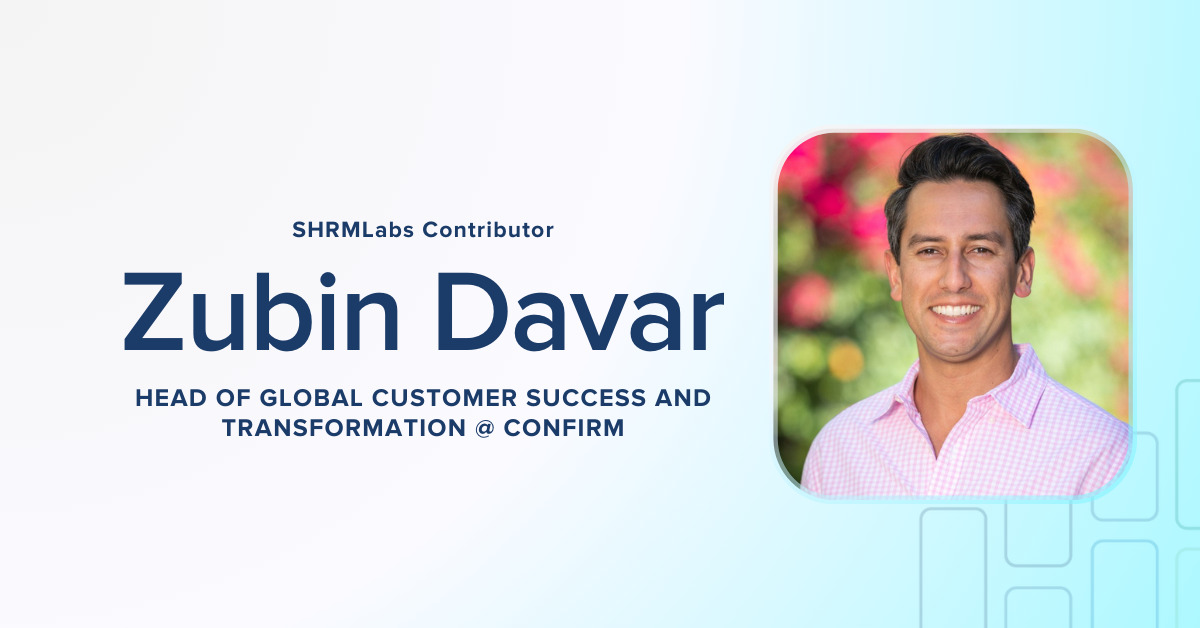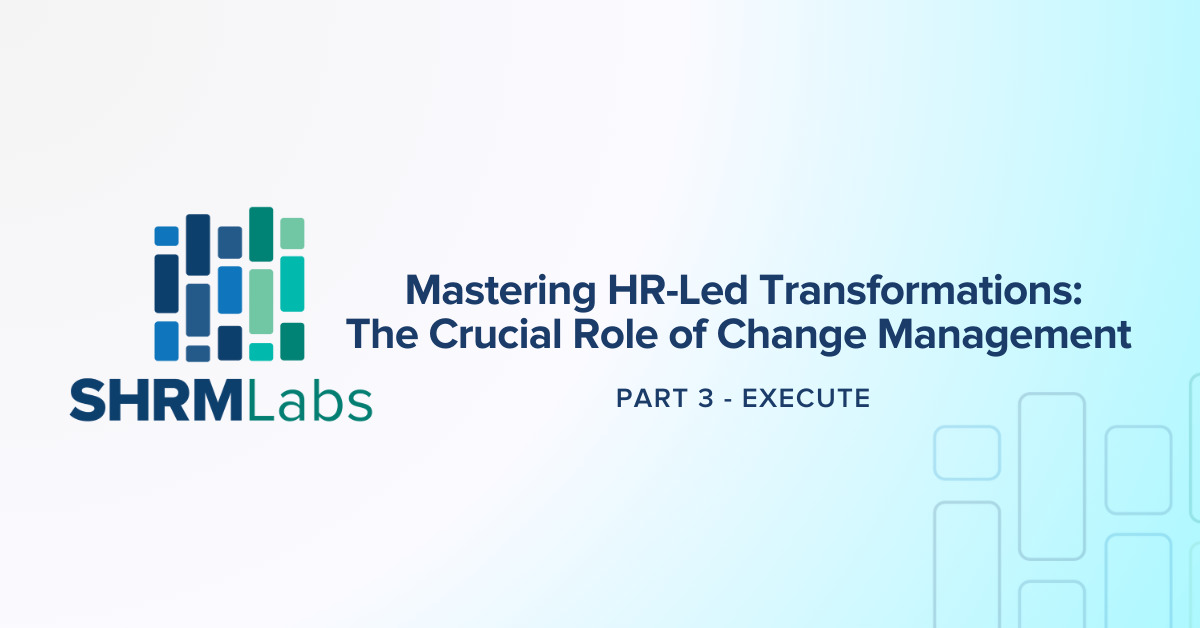Before we begin…
Welcome to our brand new SHRMLabs newsletter. We are expanding our resources to bring you the best possible information from leaders in HR technology and transformation.
My name is Trevor Schachner, Product Manager and Workplace Innovation Specialist at SHRMLabs. You will hear from me as well as my colleagues every other week with the release of each new edition. Let us know any topics you’d like to hear about related to workplace tech and we will consider them for future editions of the WorkplaceTech Pulse.

Hi, Zubin here. Welcome to the third installment of our four-part series on Mastering HR-Led Change Management. I head up global customer success and transformation at Confirm, which includes our change management practice that helps HR leaders transition to superior performance and talent management solutions.
If you’re just joining us, you can get caught up on the first two articles in this series here. To quickly recap:
In the first article we discussed the Analyze Phase. It focuses on assessing the current state, identifying stakeholders, evaluating organizational readiness and developing a high-level change plan. Activities include stakeholder analysis, change impact assessment and organizational culture mapping.
The second article explained the Build Phase, which involves constructing the detailed change management implementation plan. Key steps include finalizing the impact assessment, developing communications and training materials, and compiling the comprehensive change management plan.
In this article, we’ll dive into the pivotal Execute Phase, which brings the change plan to life. This phase is all about effective rollout through rigorous preparation, continuous performance tracking and ongoing support.
This is part 3 of a 4-part series! Want to learn more about change management?
Part 1: Analyze
Part 2: Build
Part 3: Execute ← This edition!
Part 4: Embed
Change Management Framework Review
Before getting into the Execute Phase, let’s review the change management framework.
Confirm’s approach includes four core phases: Analyze, Build, Execute and Embed. Below is a high-level overview of each phase. The remainder of this article will focus on the Execute Phase, with the other phases covered in separate articles.
- Analyze Phase. Key activities include a stakeholder analysis, organizational readiness assessment, change impact assessment, culture map, and high-level communications, training and adoption plan.
- Build Phase. Key activities include identifying skills gaps, creating a comprehensive change plan, assessing the change’s impact, and success metrics.
- Execute Phase. Key actions involve conducting a readiness assessment, refining training materials, defining performance metrics and delivering a support framework.
- Embed Phase. Activities involve continuous assessment, performance measurement, success criteria evaluation, utilization monitoring, and recognition to ensure that the change is effectively integrated and sustained within the organization.
The Execute Phase: Bringing Change to Life
The Execute Phase is where the rubber meets the road in your HR transformation journey. At Confirm, we’ve seen it spark the “aha!” moment when organizations realize the value of their new process. For context, Confirm is an all-in-one people platform grounded in the science of organizational network analysis, making performance reviews fairer, faster and simpler (you can read more here). At Confirm, we realized that while we had made champions out of those who bought the product, we hadn’t thought of a scalable way to bring every single employee and executive along on the same journey the buyers had gone through. This led to suboptimal adoption, uneven views of value, and resistance to change. Change management allowed us to bring people along on the journey, at scale, ensuring that we began engagements on the right foot and minimized time-to-value.
The Execute Phase marks the third step in the change management process. It’s the stage where all the planning and preparation come to life. This phase is crucial for ensuring that the desired changes are effectively implemented and your organization successfully transitions to the new HR framework and process. Critical actions in this phase include:
- Conducting readiness assessments before launch.
- Refining training and communications based on feedback.
- Developing processes for issue escalation.
- Defining success metrics and key performance indicators.
- Creating a support model and help resources.
- Monitoring system adoption and user engagement.
Getting It Right: Best Practices for the Execute Phase
1. Ensure a smooth transition and minimize disruptions.
Anticipating and proactively addressing any glitches in the rollout process is crucial for minimizing disruptions. Conducting thorough user testing, developing contingency plans and using change agents to provide support during launch can facilitate a smooth transition. Strong project management principles must be applied, with disciplined tracking of progress against the plan.
2. Maximize the success of HR transformations.
Define measurable success criteria upfront, track progress rigorously using KPIs and course-correct quickly if targets aren’t being met. Use pulse surveys and focus groups to regularly gather user feedback. Celebrate milestones and seed network insights to showcase benefits. These actions help maximize adoption, positioning the HR transformation for success.
3. Provide strong leadership and involve stakeholders.
The continued involvement of sponsors and change champions is critical in this phase. They must demonstrate commitment, address concerns and motivate employees throughout the execution process. HR leaders can inspire buy-in by highlighting how the transformation enables employees and unlocks new opportunities.
4. Apply proven tools and a structured approach.
Confirm guides organizations through effective execution using proven tools and a structured approach:
- Readiness assessment. Evaluate if the organization is truly prepared for the change rollout through leadership alignment checks, user readiness surveys and process preparedness audits.
- Training refinement. Incorporate feedback from pilot groups into training programs. Assess knowledge retention through quizzes and demonstrations.
- Performance tracking. Use KPI dashboards that integrate data from the new HR system to track adoption, utilization, productivity impact and other metrics.
- Support model. Create escalation processes and a help resource repository. Deploy floor support teams and power users to assist employees during launch.
The Execute Phase in Action
Let’s see how a multinational corporation executed the rollout of a new AI-powered HR system aimed at transforming talent management:
- A readiness assessment four weeks before launch revealed critical gaps in process preparedness and leadership alignment. The launch date was postponed by two weeks to address these gaps.
- Training programs were refined based on feedback from user pilot groups. Knowledge retention quizzes were incorporated to validate learning.
- KPI dashboards tracked usage across business units daily. Slow adoption in the Asia offices was spotted early, allowing for corrective action.
- Floor support teams were deployed during the first two weeks to help employees navigate the new system. An online help portal was also launched.
While initially delayed, the refined execution process resulted in a smooth rollout. The KPI tracking enabled rapid resolution of issues, while change champions and the support model facilitated user adoption across regions. Within months, the HR transformation delivered a 15 percent increase in workforce productivity.
Conclusion
The Execute Phase of change management brings the transformation plan to life through rigorous readiness checks, training refinement, performance tracking and ongoing user support for smooth execution. Meticulous planning and coordination are vital during this phase as this is when expectations meet reality. While anticipating challenges, the project team must proactively address any hiccups. Strong leadership commitment and rigorous performance tracking against defined success metrics are essential. Ongoing support and training refinement enable employees to embrace the transformation with minimal disruption. When the phase is executed effectively, organizations can successfully transition to the desired future state, realizing the full benefits of HR transformation.
Stay tuned for our next article, which will provide insights into the final Embed Phase—the last mile that sustains change and drives long-term success.
Thank you for joining us for this edition of the SHRM Labs WorkplaceTech Pulse! And thanks to Zubin and the Confirm team for their contributions and expertise on the topic of change management. Please click the link below to learn more about Confirm and the great work they are doing around performance management. We will see you next time!

Confirm is the first platform to inject science into performance reviews, ensuring advancement is based on data, not company politics. Grounded in the science of organizational network analysis (ONA), Confirm quantifies employee influence and impact, and gives leaders clear visibility into who they can’t afford to lose.

SHRM Labs, powered by SHRM, is inspiring innovation to create better workplace technologies that solve today’s most pressing workplace challenges. We are SHRM’s workplace innovation and venture capital arm. We are Leaders, Innovators, Strategic Partners, and Investors that create better workplaces and solve challenges related to the future of work. We put the power of SHRM behind the next generation of workplace technology.




